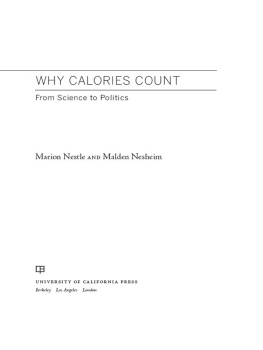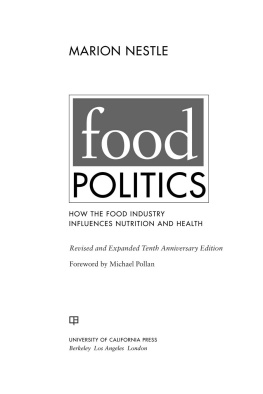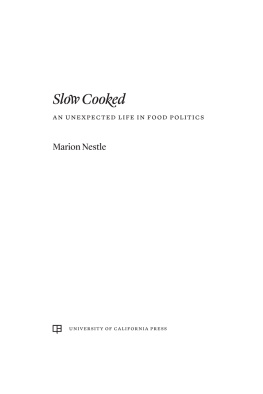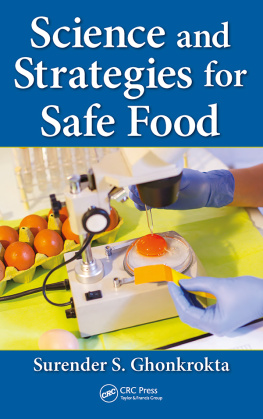ACKNOWLEDGMENTS
THE GENESIS OF THIS BOOK LIES WITH WARREN BELASCO, JOAN Gussow, and Sheldon Margen, who read the manuscript of Food Politics and argued that the food safety material would work better as a separate entity. My dear sponsor at the University of California Press, Stan Holwitz, agreed to take on this second project. The formidable editor John Bergez guided the manuscript reconstruction; I could not have a better writing teacher. Extraordinarily generous friends, colleagues, and relatives read and commented on specific chapters or sections of the manuscript at various stages of preparation: Philip Benfey, Jennifer Berg, Elinor Blake, Lee Compton, Laramie Dennis, Beth Dixon, Carol Tucker Foreman, Jeffrey Fox, Mark Furstenberg, Janna Howley, Kristie Lancaster, Trish Lobenfeld, Mimi Martin, Margaret Mellon, Richard Novick, Domingo Piero, Robert Moss, and Fred Tripp. I am greatly indebted to Joanne Csete, Ellen Fried, and Rebecca Nestle, who read the entire draft of the bookacts of courage that extended well beyond the demands of friendship, collegiality, and filial affection.
Many people provided information or documents to which I might not otherwise have had access: James Behnke, Jennifer Cohen, Dennis Dalton, Caroline Smith DeWaal, Carol Tucker Foreman, Rebecca Gold-burg, Karen Heisler, Michael Jacobson, James Liebman, Charles Margulies, Robert Marshak, George Pillsbury, Sarah Pillsbury, Krishnendu Ray, Michael Taylor, Catherine Woteki, Annette Yonke, and Lisa Young. For several years, Christine McCullum has been forwarding information on biotechnology gleaned from the Internet, carefully filtered to include just what I most needed to know. Kristie Lancaster, Domingo Piero, and Sheldon Watts graciously dropped whatever they were doing to help me deal with computer emergencies. Rob Kaufelt (Murrays Cheese) and Peter Kindel (Artisanal) asked questions about cheese, and Sara Firebaugh helped answer them. I also thank all the other contributors of information and materials who preferred to remain anonymous. Finally, I borrowed the title of this book from Safe Food: Eating Wisely in a Risky World (Living Planet Press, 1991, but now sadly out of print), for which I thank Michael Jacobson and his colleagues at the Center for Science in the Public Interest.
At a particularly difficult moment during the manuscript revision, Margaret Mellon provided inspiration. For encouragement throughout I am grateful to my agent, Lydia Wills; to Wendel Brunner, Loma Flowers, Ruth Rosen, JoAnn Silverstein, and Sam Silverstein; to my Moss cousins, and to my children and their partners: Rebecca Nestle and Michael Suenkel, and Charles Nestle and Lidia Lustig. I owe special thanks to my extraordinary colleagues in the Department of Nutrition and Food Studies at NYU for their forbearance and assistance and review of the manuscript at every stage of preparation, particularly to Alyce Conrad for designing several of the more complicated illustrations, Fred Tripp for his daily clipping service to the Wall Street Journal, Ellen Fried for expert research assistance and review of the manuscript at every stage of preparation, and Jessica Fischetti and Kelli Ranieri for office life support. Dean Ann Marcus granted sabbatical leave, and Deans LaRue Allen, Gabriel Carras, and Thomas James granted much else in the way of encouragement. I recognize and very much appreciate the unusual level of care and attention given to Safe Food by the production and design teams at the University of California Press and BookMatters. Preparation of this book was supported in part by research development grants from New York University and its Steinhardt School.
APPENDIX
THE SCIENCE OF PLANT BIOTECHNOLOGY
IN WRITING THIS BOOK, I TRIED TO MAKE THE SCIENTIFIC ISSUES accessible to general readers, omitting technical details but retaining accuracy. The purpose of this appendix is to provide a bit more information about the underlying science of food biotechnology. Although it is not necessary to know very much about this science in order to understand its political implications, a grasp of fundamental concepts, approaches, and interpretations can help bridge the gap between science-based and value-based approaches to evaluating risk. At the very least, this information helps to explain why some scientists have difficulty understanding public distrust of genetically engineered foods.
Science has much to teach us about the biological and physical worlds we inhabit, and its methods and approaches are useful tools for investigating such matters. The basic concepts are not difficult to understand, but the methodsand especially the vocabularycan be intimidating. Here, I extend the discussion of plant biotechnology given in and offer further details, still nontechnical, about the methods used to introduce new genes into plants, particularly those for synthesis of beta-carotene in Golden Rice. Lets begin with a brief overview of basic biological principles having to do with DNA and its functions in bacteria and plants.
A (VERY) QUICK REMINDER ABOUT DNA, GENES, AND PROTEINS
DNA (deoxyribonucleic acid) is the principal determinant of the genetic characteristics of most living organisms: humans, animals, plants, bacteria, and many viruses. One of its functions is to specify the structure of proteins. The details of the processes through which DNA reproduces itself and carries out its functions appear immensely complicatedalways a good sign that they are incompletely understood. They are also abstract. DNA and proteins are submicroscopic; their actions must be inferred. Furthermore, scientists (like specialists in any field) typically describe molecular actions in a vocabulary impenetrable to the uninitiated.
No matter what organism it comes from, DNA is composed of just four subunitsthe DNA bases. These differ in size and shape and are arranged on the DNA molecule like beads on a string. The sequence of stringing constitutes a four-letter code that contains the genetic information of the cells that make up body organs and tissues. To summarize the basic details:
Sequences of DNA bases (DNA segments) arranged in a specified order constitute genes.
Some gene DNA sequences specify the structure of proteins.
Other DNA sequences specify the structure of molecules that signal where genes begin and end.
Gene DNA sequences specify the order in which amino acids link to make specific proteins; a sequence of three DNA bases specifies 1 of the 20 amino acids (this is the genetic code).
Proteins are composed of various combinations of the 20 different amino acids linked in a specific order defined by the gene DNA sequence.
Proteins do the work of cells, muscles, and other organs as structural components, signals, or enzymes.
Enzymes catalyze biochemical reactions in the body.
The structure of DNA is helical; its two strands are twisted around each other in a double helix.
Proteins differ from one another in structure; they fold into specific three-dimensional shapes that depend on the sequence of their amino acids (and other components that may be introduced during or after protein synthesis).
The structure of a protein determines its function.
These biological features operate in the same way in most organisms. Differences among species depend on the specific order of base sequences in their DNA and, therefore, in the sequence of amino acids in their proteins. When scientists extract genes from bacteria, they are taking segments of DNA that contain the same DNA bases that are already in plantsjust arranged in a different sequence. The commonality of DNA bases among organisms is the main reason why many scientists are perplexed by public anxieties about genetic engineering; DNA is DNAits base subunits are the sameno matter where it comes from or where it goes.





